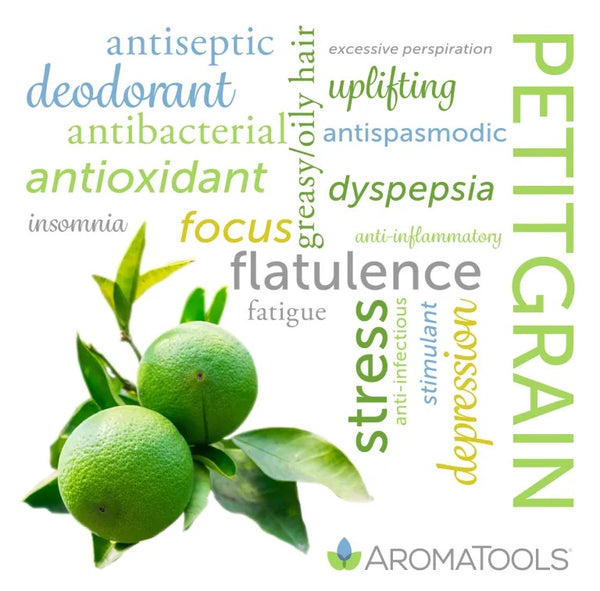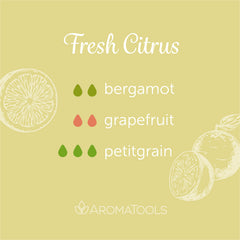Your Cart is Empty
Shop by Category
Essential Oil Spotlight: Petitgrain

Petitgrain essential oil (Citrus aurantium) is obtained from the bitter orange tree. It is distilled from leaves and sometimes the tips of young twigs, but in earlier centuries it was extracted from unripe oranges, picked when they were still green and no bigger than a cherry, hence the French term petit grain, meaning “small grain.” This was uneconomic because in the effort to produce petitgrain essential oil, the crops of mature oranges were reduced drastically. So rather than producing oil from the unripe fruit, producers started distilling oil from the leaves of the tree and kept the oil’s original name. Because of its very pleasing scent, petitgrain has been used extensively in high-quality perfumes and cosmetics.
Petitgrain essential oil contains antibacterial, anti-infectious, anti-inflammatory, antioxidant, antiseptic, antispasmodic, deodorant, and stimulant (for digestive and nervous systems) properties.
It is commonly used for depression, focus, greasy/oily hair, stress, and uplifting one’s mood. This oil may also help with acne, dyspepsia, fatigue, flatulence, greasy hair, insomnia, and excessive perspiration.
Petitgrain essential oil can be applied neat (with no dilution) on adults when used topically on area of concern or reflex points. It can also be diffused or inhaled directly and is generally regarded as safe for internal use (often consumed in small amounts in capsules).
5 Ways To Use Petitgrain Essential Oil
1. Diffuse
Petitgrain is a great oil to diffuse because it has the ability to uplift one’s mood and may help with stress, focus, and depression. Try these blends in your diffuser:


2. Roll on for Sleep
Petitgrain essential oil is also beneficial in helping with insomnia (especially when sleeplessness is caused because of loneliness or stress). Here is a good recipe to put in a roll-on bottle to rub on the bottoms of your feet at night when you need a little help falling asleep:
|
Sleepy Time with Petitgrain Roll-on Blend: 2 drops lavender 2 drops Roman chamomile 7 drops petitgrain Add oils to a 5 ml roll-on for short-term use or a 10 ml roll-on for daily use. Fill the roll-on the rest of the way with a carrier oil such as fractionated coconut oil, sweet almond oil, or jojoba oil. |

3. Add to Deodorant
Try putting petitgrain in your all-natural deodorant. You could even make your own using this recipe and replace the oils with this blend:
4 drops lime
4 drops orange
2 drops clove
2 drops petitgrain
4. Add to a Warm Bath
Petitgrain is most known for its ability to help with depression and for supporting the nervous system. It is a good alternative to use in place of bergamot essential oil when needed over a long period of time or when the photosensitive nature of bergamot is a problem (petitgrain essential oil is not a photosensitizer). Try adding petitgrain essential oil to your baths! Just mix the oil with epsom salt before adding to warm bathwater. Here are a few recipes to try:
|
A Refreshing Calm: 5 drops petitgrain 5 drops ylang ylang 5 drops orange 1/4 cup (60 g) Epsom Salt |
Relaxing with Petitgrain: 5 drops petitgrain 5 drops lavender 3 drops fennel 2 drops orange 1/4 cup (60 g) Epsom Salt |
Good Morning, Sunshine: 4 drops rosemary 6 drops grapefruit 5 drops petitgrain 1/4 cup (60 g) Epsom Salt |

5. Care for Greasy/Oily Skin and Hair
Petitgrain essential oil has many applications in skincare because it helps to reduce over-production of sebum and is a gentle but effective antiseptic. This makes it a good oil for acne or oily dandruff. Just put a few drops in the final rinse after shampooing greasy hair, or apply after washing your face.
To learn more about petitgrain essential oil, see the book Modern Essentials : A Contemporary Guide to the Therapeutic Use of Essential Oils.
: A Contemporary Guide to the Therapeutic Use of Essential Oils.
Sources: Modern Essentials : A Contemporary Guide to the Therapeutic Use of Essential Oils, 8th Edition, p. 101.
: A Contemporary Guide to the Therapeutic Use of Essential Oils, 8th Edition, p. 101.
Healing Oils: 500 Formulas for Aromatherapy by Carol Schiller & David Schiller
Aromatherapy: An A–Z by Patricia Davis
Aromatherapy Blends & Remedies by Franzesca Watson
Leave a comment
Comments will be approved before showing up.
Also in Essential Ideas by AromaTools

Lavender Bubble Bath Salts
bath Body Care Recipes castile soap Epsom salt Essential Ideas Gift Ideas jojoba oil lavender skin care
If you’re looking for a fun new twist on your traditional bath salt recipe, this is the one for you! By combining epsom salt with castile soap and jojoba oil, your bath is taken to a new level.
Read More
“Essentially You” Shampoo & Conditioner
Body Care Recipes castile soap conditioner Essential Ideas essential oils hair care shampoo sweet almond oil vegetable glycerin vinegar
Customized hair care is a booming business on the internet. Just how is it done? Basically, an online quiz—about hair type and health, desired care outcomes, and perhaps lifestyle and environment—determines each individual’s formulas. Naturally, these personalized products are much …
Read More
Luxurious Bath Bombs
bath Body Care Recipes Citric Acid Epsom salt Essential Ideas essential oils fractionated coconut oil relax skin care sweet almond oil witch hazel
Baths can be relaxing or energizing depending on the time of day, the temperature of the water, and the essential oils you use. These bath bombs will take an average bath to the next level and make it luxurious! You …
Read More Essential Ideas and More
We love sharing tips and tricks on how to safely and effectively use essential oils. Join in on the conversation!
Popular Articles This Month
10 Diffuser Blends for the Road
Essential Oils for Heart Health & Cardiovascular Support
Lighten Your Hair Naturally with Essential Oils
Essential Oil Gummy Candies for Immune Support
Essential Oil Spotlight: Blue Lotus
Men's Cologne with Essential Oils
The Art of Roller Bottle Blending
Keys to Successful Essential Oil Classes (Including 50+ Class Ideas)
Get recipes & ideas delivered to your inbox
Sign up for our newsletter to learn about releases, exclusive deals and more!






